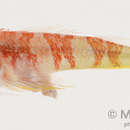mk
имиња во трошки


No information was found on communication in Tripterygiidae, except regarding courtship displays by males (see Reproduction: Mating Systems).
Communication Channels: visual ; acoustic
Perception Channels: visual ; tactile ; acoustic ; chemical
Currently, there is no known conservation threat to any member of this family.
Sticky threads anchor the eggs of triplefin blennies to algae in the nest site. After hatching, larvae in species of Tripterygion settle after approximately 40 days. One study indicates that larvae are affected by auditory cues (reef sounds) in determining where to settle.
Tripterygiids (triplefin blennies) are one of the least-studied blennies, but they are known to be cryptic, territorial reef dwellers identifiable by their three distinct dorsal fins and ctenoid (rough-edged) scales. There are some undescribed forms among the Tripterygiidae, but there are thought to be at least 20 genera and 150 species in the family.
No specific information was found concerning any negative impacts to humans.
Some triplefin blennies are kept in aquaria, but none are considered sport or food fishes.
Positive Impacts: pet trade
Triplefin blennies have in many cases adapted to specialized local conditions, so they may occupy otherwise unfilled roles in certain areas. They feed on and thereby impact populations of small invertebrates, and likewise may affect algal growth.
Triplefin blennies feed on algae and tiny invertebrates.
Primary Diet: carnivore (Eats non-insect arthropods); herbivore ; omnivore ; planktivore
Triplefin blennies are found in the Atlantic, Pacific, and Indian Oceans, and one species has been identified in the Antarctic Peninsula. There are five species known to be from the Bahamas, all of which are located in the Bahamas. Blennies are generally not found on most of the Atlantic coasts of Africa and South America. New Zealand is thought to be the area with greatest diversity of triplefin blennies.
Biogeographic Regions: indian ocean (Native ); atlantic ocean (Native ); pacific ocean (Native )
Primarily benthic reef-dwellers in tropical and warm temperate seas, triplefin blennies commonly live near reef surfaces, rocky slopes, rubble, or algae-covered rocks. Depth and habitat can vary according to specific local adaptations. One species can sometimes be found in estuaries.
Habitat Regions: tropical ; saltwater or marine
Aquatic Biomes: benthic ; reef ; brackish water
Other Habitat Features: estuarine ; intertidal or littoral
No information was found regarding the lifespan of Tripterygiidae.
Triplefin blennies are cryptically colored or transparent, heavily scaled, and small. Most are only 3-4 cm, the largest reaching 25 cm. In triplefin blennies the dorsal fin is divided into three distinct parts. The first two segments are composed of numerous slender spines, and the third segment is made up of at least seven soft rays. There are between zero and two anal fin spines. Scales are usually, but not universally, ctenoid (rough-edged or toothed). The nape lacks cirri, and the first gill arch attaches to the operculum, the latter characteristic distinguishing Tripterygiidae from Clinidae. Sexual dimorphism is common, with males assuming black or red coloration on the head, body, or caudal fin during spawning. Urogenital (involving both the urinary and genital structures) morphology may also differ between males and females. Gray and brown are typical colors on females and nonspawning males. (Click here to see a fish diagram).
Other Physical Features: ectothermic ; bilateral symmetry
Sexual Dimorphism: male more colorful; sexes shaped differently
Triplefin blennies avoid predators by attempting to remain unnoticed. They are small, occupy hiding places in the reef, and are cryptically colored or partially transparent.
Anti-predator Adaptations: cryptic
Male triplefin blennies establish territories on rocks covered with algae. From this vantage point they signal to passing females by “loop-swimming,” a courtship motion that varies from species to species, but entails quickly hopping up and down in a loop. Males of species in Axoclinus pose before loop-swimming, resting on their pelvic fins and waving the caudal fin, which gives the female a better chance to view his courtship colors. One male may spawn with several females.
Mating System: polygynous
Definitive information about spawning seasons of triplefin blennies is lacking, but spawning likely occurs year-round in the tropics and during warmer seasons in temperate areas. In order to spawn the male first cleans the algal filaments at the nest site, and then attracts one or more females to the nest. Spawning can last up to several hours. Eggs are deposited by the female one at a time and fertilized simultaneously by the male, with clutch sizes sometimes reaching 500 eggs. “Streaking” occurs in some species of Tripterygion and Axoclinus: smaller, most likely younger, cryptically-colored males rush in while the dominant male is engaged in spawning, releasing their own sperm in an attempt to fertilize some of the eggs.
Key Reproductive Features: iteroparous ; gonochoric/gonochoristic/dioecious (sexes separate); sexual ; fertilization (External ); oviparous
Male triplefin blennies remain near the eggs to guard them until they hatch.